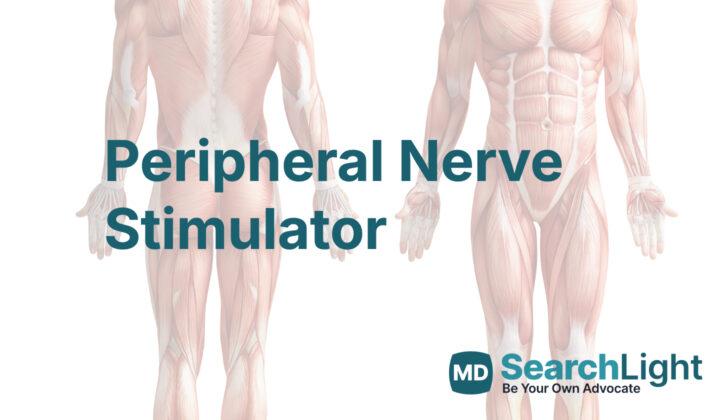Overview of Peripheral Nerve Stimulator
Chronic pain, or pain that lasts a long time, is one of the top reasons people have disabilities all over the world. Dealing with this kind of pain can be tricky, especially because of the rise in deaths related to opioids, which is a type of strong painkiller. Because of this, doctors who specialize in pain are starting to turn more and more to solutions that don’t involve opioids.
One of these options is something called a peripheral nerve stimulator. This is a device that helps manage both long-term and sudden, severe pain (check out the picture to see what it looks like). In the past, these stimulators have been used for a specific type of long-term pain, called chronic neuropathic pain, in patients who aren’t able to have a spinal cord stimulator put in. The stimulator leads, which are small wires, have usually been put in permanently for those with this type of pain.
Additionally, a peripheral nerve stimulator might even be used after surgery to help control the pain. This is an area that hasn’t been completely explored yet, but there are several research studies that suggest using these things could be a good addition to what’s currently being done to manage pain.
Anatomy and Physiology of Peripheral Nerve Stimulator
To ease pain, doctors sometimes use a device called a peripheral nerve stimulator. They put a small wire called a lead near a nerve in the part of the body where the pain is happening. This device works similarly to a tool called a continuous peripheral nerve block. Since the two share similar approaches, the lead could theoretically be placed in any location where nerve block is commonly used.
Studies with human models (cadavers) show that suitable sites in the lower part of the body include the tibial nerve (in your calf), peroneal nerve (in your lower leg), sciatic nerve (running from your lower back down each leg), and lateral sural nerve (in the back of your knee and calf). In the upper body, feasible locations are the radial nerve (in your forearm), median nerve (down the middle of your forearm), and ulnar nerve (in your arm and hand).
However, doctors can use the nerve stimulator successfully on other nerves too. The best way to place the lead is parallel, or alongside, a nerve.
Why do People Need Peripheral Nerve Stimulator
A peripheral nerve stimulator is a device used to treat various conditions that cause nerve-related pain. This type of pain usually affects a certain area of the body related to a specific nerve. For example, such conditions can include but are not limited to:
1. Pain caused by damage to the median, ulnar, or radial nerves in the arm.
2. Occipital neuralgia, a condition where there’s pain at the back of the head.
3. Cluneal nerve pain, which affects the lower back or buttocks.
4. Pudendal neuralgia, causing discomfort in the area between the buttocks.
5. Conditions involving the femoral, sciatic, or obturator nerves in the legs.
6. Brachial or lumbar plexus neuropathy, causing pain in the arm or lower back.
7. Meralgia paresthetica, causing a burning sensation in the outer thigh.
8. Lumbar or cervical radiculitis, relating to nerve pain in the lower back or neck.
9. Intercostal neuralgia, causing pain in the chest.
When you experience these types of pain, your doctor may suggest using a peripheral nerve stimulator as a treatment option.
When a Person Should Avoid Peripheral Nerve Stimulator
There are certain situations where installing a peripheral nerve stimulator, a device used to treat nerve pain, can’t be done. There are two main reasons for this:
Firstly, if the patient is allergic to any part of the stimulator, it cannot be put in. Equally important, if the patient doesn’t want the stimulator, they have the right to refuse, and it will not be placed.
In other situations, it might be risky to put in a stimulator, but it could still be considered. If the patient has a problem with their blood that makes it hard for cuts to clot and stop bleeding, known as a coagulopathy, this could make putting in the stimulator risky. If there’s also an infection in the area where the stimulator would be put in, this could also cause problems.
Equipment used for Peripheral Nerve Stimulator
When a doctor needs to set up a peripheral nerve stimulator device, several pieces of equipment are required. These include an ultrasound machine, which helps the doctor see where the nerve that will receive the stimulator is located. It’s important to keep everything clean during this process, so sterility tools are essential. For the device to be placed correctly, the doctor will use special types of needles and a sterile dressing.
It doesn’t matter which ultrasound machine is used, as long as it has either a curved or linear array transducer. This device will need a clean cover, known as a transducer sleeve, for this procedure. Prior to inserting the stimulator, the doctor will numb your skin with a small dose of local anesthetic.
The doctor will also use a needle electrode to check if the stimulator is in the optimum position. To place the stimulator device, an introducer needle and a stimulator lead are used. A machine that can deliver electrical stimulation is also necessary to check the stimulator and to provide ongoing stimulation.
To ensure a sterile field, the doctor will wear gloves, a surgical cap, and a mask. Prepping your skin with chlorhexidine, an antiseptic solution, is also a recommended step to prevent infections. After inserting the stimulator, the doctor will cover the area with a sterile dressing. This dressing will help maintain the placement of the stimulator lead.
Who is needed to perform Peripheral Nerve Stimulator?
Medical professionals who are trained in the placement of devices called peripheral nerve stimulators usually can do this procedure by themselves or with one helper. These devices are used to control pain by sending electrical signals to the nerves. The procedure is typically carried out by doctors specialized in pain management or anesthesiology (doctors who control pain during surgeries), or by nurses who are specially certified in anesthesia.
Preparing for Peripheral Nerve Stimulator
Before starting the procedure, the doctors will make sure that you fully understand what will be done and get your consent. They will use a device called an ultrasound to look at the inside of your body and decide the best place to put the medical device called a lead. They then clean your skin with an alcohol-based liquid, chlorhexidine, to kill any germs and prevent infection. If you have a known issue using chlorhexidine, a different solution will be used. All medical staff involved will put on special protective clothing and sterile gloves. They’ll cover you with clean sheets, leaving only the area for the procedure exposed.
How is Peripheral Nerve Stimulator performed
The process of providing anesthesia, or a method of controlling pain, begins by numbing the area where the needle will be inserted. This is done by injecting a local anesthetic, a medicine that temporarily reduces sensation or pain in a part of the body.Ultrasound, which uses sound waves to create images of the inside of the body, helps guide this process. A little lump, often called a skin wheal, is created to make sure the skin is numb. A special type of needle called a monopolar needle is guided by ultrasound towards the nerve, staying about 0.5 to 1 centimeter away.
A device known as an electrical stimulator is connected to the needle. This device sends a tiny electric pulse through the needle to test the placement. If the placement of the needle is too close to the skin, it may cause uncomfortable sensations. If the needle is too deep, it can cause discomfort or muscle contractions in a region farther from the insertion point. Therefore, the doctor keeps adjusting the location of the stimulator needle until neither of these sensations are felt.
The monopolar needle is then removed, and a different tool, called an introducer needle, is placed in the same spot. This needle contains the stimulator lead, which is like a thin wire. This wire will stay in your body to continue the stimulation. After the needle is safely removed, the lead left behind can be connected to the stimulator device. Additionally, a surface electrode, a device that picks up electrical signals from your body, is placed on the same side of your body as the insertion.
The lead and stimulator work together to create sensations in the desired area of the body without causing muscle contractions. Once the comfortable placement is confirmed, the lead is held in place with a clean dressing, to prevent infection.
Possible Complications of Peripheral Nerve Stimulator
Peripheral nerve stimulators are medical devices used for various treatments, but like all procedures, they may have some complications. The complications include pain during the installation of the device, infection, the movement of the lead (a wire that connects the device to the nerve), breaking or misplacement of the lead, allergic skin reactions, discomfort from the electric stimulation, and the formation of a hematoma (a mass of usually clotted blood that forms in a tissue, organ, or body space).
The most frequent complication is the movement of the lead, especially with long-term use of the stimulators. Infections could happen in around 4 to 10% of cases, and they would require treatment with antibiotics, removal of the lead wire, or both. It is important to note that long-term nerve damage is a rare but serious complication that could potentially occur with the use of peripheral nerve stimulators.
What Else Should I Know About Peripheral Nerve Stimulator?
Using peripheral nerve stimulators, a type of device used to reduce pain, could drastically alter how healthcare providers treat patients. This shift could greatly improve patient satisfaction and quality of life. Some research has suggested that these devices can effectively manage post-surgery and sudden pain without relying heavily on opioid pain medications.
This development is particularly promising considering the current crisis of opioid misuse in America. Peripheral nerve stimulators have the added benefit of providing local anesthesia, which numbs a specific part of the body without affecting the rest of the body, rather than the widespread effects often seen with many pain medications. This means that patients with chronic nerve pain who aren’t suitable for spinal cord stimulator placement could find lasting relief with these devices, sidestepping the negative side effects of pain pills.
One potential issue with another kind of pain management – peripheral nerve blocks using local anesthetic – is that it can cause muscle weakness. However, peripheral nerve stimulation might be able to avoid this unwanted side effect. Although there is still a lot to learn in this field, some early studies have shown the potential of peripheral nerve stimulation as a supplement to current pain management methods.












